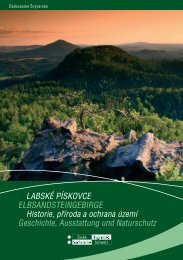ABSTRACT BOOK Sandstone Landscapes ... - Sandstones.org
ABSTRACT BOOK Sandstone Landscapes ... - Sandstones.org
ABSTRACT BOOK Sandstone Landscapes ... - Sandstones.org
Create successful ePaper yourself
Turn your PDF publications into a flip-book with our unique Google optimized e-Paper software.
ŚWIERKOSZ K. 1999. Ocena wartości przyrodniczej wybranych zbiorowisk roślinnych PNGS [w:] M.ZGORZELSKI [red.] Góry Stołowe. Wydawnictwo Akademickie “Dialog’. s. 131. (In Polish).ŚWIERKOSZ K. 1999. Zestawienie zbiorowisk roślinnych stwierdzonych na terenie PNGS [w:] M.ZGORZELSKI [red.] Góry Stołowe. Wydawnictwo Akademickie “Dialog”. s. 128-130. (In Polish).TKarel TajovskýInstitute of Soil Biology, Academy of Sciences of the Czech Republic, Na Sádkách 7, CZ-370 05 ČeskéBudějovice, Czech Republic (tajov@upb.cas.cz)Terrestrial arthropods (Oniscidea, Diplopoda, Chilopoda) of the sandstone and adjacent habitats inBohemian Switzerland National ParkUp to the end of the twentieth century, only several scarce data about the faunas of terrestrial isopods,millipedes and centipedes of the Elbe sandstone area and surrounding territories were known. Only generalinformation about the centipedes, except for Geophilus flavus, was published by Rosický (1876) andFolkmanová (1928). More detail analysis of the millipede fauna of North Bohemia and the neighbouringSaxonia proposed Verhoeff (1910) and the list of terrestrial isopods has been summarised by Flasarová(1995).In 1996, hand sorting, soil sampling and pitfall trapping were used for the faunistic as well as cenologicalresearch on these three groups of soil macrofauna. Further sampling in another localities including thealluvium of the Elbe River later on completed extended material, collected during this year. The mainresults based on this research have been already subsequently published (Tajovský, 1998, 2001).The centipede species Schendyla montana and Lithobius tenebrosus fennoscandius were noted here for thefirst time for the Czech Republic. The record of Unciger transsilvanicus in the Arba Nature Reserverepresents the north-westernmost occurrence of this species in Europe. The highest numbers of millipedeand centipede species were found in beech forests (Melico-Fagetum) covering basalt summits (RůžákNational Nature Reserve, Mlýny, Purkartický les). Acidophilous beech forests and deep sandstone passeswere poor in millipede and partly in isopod faunas, but usually not in centipede assemblages. Wet meadowsand forests of open valleys were the richest ones in population densities of isopods (970-1030 ind.m -2 ) andcentipedes (up to 522 ind.m -2 ). The narrow alluvium along the Elbe River is characterized by presence ofsome species typical for wetland habitats (e.g. the millipede Julus scanicus, the centipede Lamyctesemarginatus). The Elbe River valley represents a possible corridor between the central and west European(atlantic) areas, as confirmed for example the occurrence of the millipede Polydesmus angustus andCraspedosoma germanicum.Together with literary data, 14 species of terrestrial isopods, 31 species of millipedes and 28 species ofcentipedes are known today for this whole area. Based on this data, the territory of the sandstone andadjacent habitats in Bohemian Switzerland represents on of the richest area not only in the Czech Republic,but also in the whole Central Europe.




